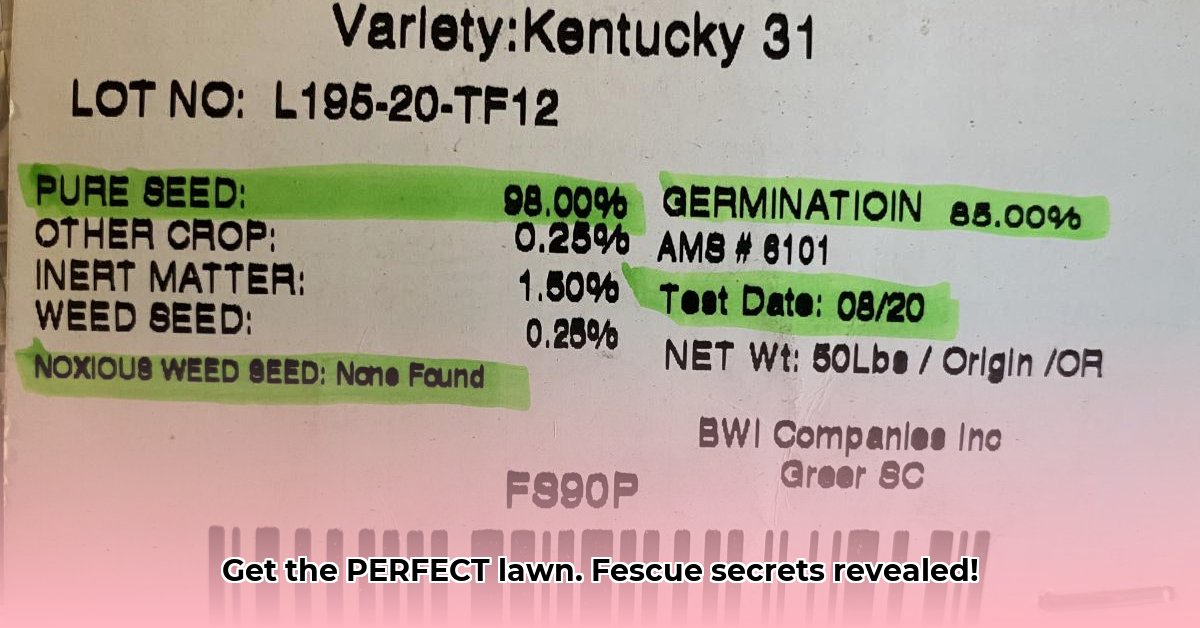
Choosing the right fescue seed is crucial for a thriving and sustainable pasture. This guide provides actionable advice for selecting and managing fescue, maximizing its benefits while minimizing environmental impact. Whether you're a seasoned farmer or just starting out, we'll equip you with the knowledge to improve your grazing land. For more information on tall fescue, check out this helpful resource: Tall Fescue Guide.
Understanding Endophytes: The Tiny Inhabitants of Your Grass
Tall fescue often contains endophytes—microscopic fungi living within the plant. These fungi can be beneficial, offering pest and disease resistance and enhancing drought tolerance. However, some endophytes produce toxins harmful to livestock, causing fescue toxicosis (a condition leading to health problems and reduced productivity). Understanding endophytes is key to choosing the right seed. This is crucial for selecting the best option for your livestock's health and the overall success of your pasture.
Picking the Perfect Fescue: Matching Seed to Your Needs
Selecting the ideal fescue variety requires careful consideration of several factors. Choosing the proper seed significantly impacts your pasture's success, yielding better results versus simply grabbing a random bag of seed.
Climate Considerations
Does your region experience hot, dry summers or harsh, freezing winters? Some fescue varieties thrive in heat, while others excel in cold climates. Choosing a variety suited to your climate ensures optimal growth and prevents plant failure.
Soil Type Analysis
Is your soil well-drained or prone to waterlogging? Is it sandy or heavy clay? Fescue varieties have soil preferences. Matching the seed to your soil type promotes healthy root development and maximizes productivity.
Livestock Compatibility
Are you raising cattle, sheep, or horses? Different livestock species have varying sensitivities to endophytes. Choosing a variety compatible with your livestock's needs protects their health and well-being.
Endophyte Status: A Critical Decision
Fescue seed comes in three main types regarding endophyte presence:
Endophyte-Free: These lack endophytes, eliminating the risk of toxicosis but increasing susceptibility to pests and diseases.
Traditional Endophytes: These contain endophytes offering drought and pest resistance but also carry the risk of toxicosis.
Novel Endophytes: These are newer varieties engineered to provide the benefits of traditional endophytes (drought and pest resistance) without the toxic effects. Research on their long-term effects and optimal use is ongoing.
Table 1: Fescue Variety Selection Guide
| Factor | Considerations | Tractor Supply Implications |
|---|---|---|
| Climate | Hot, dry summers need heat-tolerant varieties; cold winters require cold-hardy types. | Choose accordingly from your local store's selection. |
| Soil Type | Well-drained soils suit some varieties; others tolerate heavier clay soils. | Match the seed to your soil type for optimal growth. |
| Livestock Type | Different livestock react differently to endophytes; some are more sensitive. | Choose a variety appropriate to your animals' health needs. |
| Endophyte Status | Endophyte-free, traditional, or novel endophytes each have pros and cons. | Carefully weigh the benefits and risks of each type. |
Sustainable Grazing Practices: Maximizing Pasture Health
Even with the best fescue seed, proper pasture management is key to long-term success and environmental sustainability. Neglecting sustainable practices significantly reduces the lifespan and productivity of the pasture.
Rotational Grazing: Move your livestock regularly to different pasture areas, allowing grass to recover and preventing overgrazing. This promotes healthy plant growth and better utilization of pasture resources.
Forage Diversification: Don't rely solely on fescue. Include other forage species to improve pasture health, biodiversity, and resilience to pests and diseases. A diverse pasture is a more robust and productive pasture.
Smart Fertilization: Regular fertilization is vital, but over-fertilizing harms the environment. Conduct soil tests to determine your fertilization needs and select environmentally friendly fertilizers.
A Step-by-Step Guide to Fescue Establishment
Assess Your Needs: Evaluate your climate, soil type, and livestock type to determine the ideal fescue variety.
Research and Select: Explore your local tractor supply store’s offerings and consult with their staff to identify suitable varieties.
Plan Your Planting: Follow recommended seeding rates and techniques for the selected variety to ensure successful establishment.
Implement Sustainable Practices: Employ rotational grazing, forage diversification, and responsible fertilization to maintain a healthy and productive pasture.
Your Tractor Supply Store: A Valuable Resource
Your local tractor supply store is more than just a retailer; it’s a valuable resource for information and expert advice on fescue seed selection and pasture management. Consult their staff to get personalized guidance, leveraging their knowledge to achieve your farming objectives.
Key Takeaways:
- Choosing the right fescue seed is crucial for a thriving and sustainable pasture.
- Understanding endophytes and their impact on livestock is vital for informed decision-making.
- Sustainable grazing practices maximize pasture health and minimize environmental impact.
- Your local tractor supply store provides valuable resources and expertise.